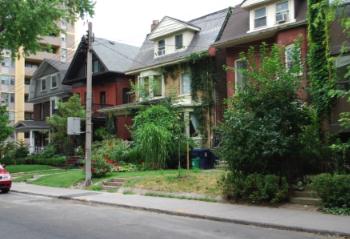
Kristyn Wong-Tam says the proposed building would overshadow Dundonald St. Credit: Kyle Lasky
Four old brick houses in the middle of Dundonald St have been sold to real estate firm Cushman & Wakefield, which is brokering a deal for the site to be developed as an 18-storey condo.
The deadline for offers on the properties at 31-37 Dundonald is July 19, and the sale has left some area residents anxious and upset. “It’s sad in regards to our city,” says Serafin LaRiviere, who has lived on the street for 12 years. “We don’t have a lot of heritage left in Toronto.”
Tree-lined Dundonald St features rows of 100-year-old three-storey brick homes, but as Toronto’s white-hot real estate market swells, downtown density is increasing and putting pressure on historic neighbourhoods.
Councillor Kristyn Wong-Tam, a local history enthusiast and former realtor, is currently working to get heritage status for the Dundonald homes in order to block the development and preserve the street’s character. City staff members have not yet delivered a report, but Wong-Tam says she is optimistic.
She says the section of the street in question is zoned for neighbourhood use, making it a less likely candidate for an 18-storey building.
In a note to potential buyers, associates at Cushman & Wakefield highlighted what they saw as their path to winning the needed variances: “The property is located in an area that has, and continues to experience significant high density residential development activity.” The statement noted that a building 20 metres to the east is also 18 storeys.
Wong-Tam argues the building mentioned is closer to Church St, where, like a similar cluster near Yonge, condo towers are more suitable. She says the proposed 118,000-square-foot building would overshadow a small street like Dundonald, which is part of a larger concern for the area.
“It’s the small streets like Gloucester, Dundonald and Monteith where you get really vibrant neighbourhood pockets. Those neighbourhood pockets, with low-rise stable housing, are absolutely essential to the Village and downtown Toronto.”
This kind of development battle is now the norm because of Toronto’s unprecedented downtown real estate boom. Another 18-storey building, with 120 units, has already been proposed for 17 Dundonald St; a first public meeting was held two weeks ago.
Wong-Tam says there will be a prolonged fight at 11 Wellesley St W to make that property a public park (for which it is zoned) rather than selling it off to be developed as a condo, and developers who have bought the Sutton Place Hotel, at 955 Bay St, want to renovate it into a 772-unit condo.
Wong-Tam says these developments do not fit with the city’s official plan of increasing density and adding housing.
“I would say that argument would have been valid up to five years ago,” she says. “But we have exceeded our provincial growth targets and we’re 20 years in advance to what the province had anticipated.” A contributing factor is the province’s greenbelt strategy, which has encouraged development downtown along transit corridors.
With the development creep encroaching on the Village’s leafy neighbourhood streets, LaRiviere also worries about the mixed character that makes the area special.
“The neighbourhood streets are slowly disappearing, which is sad . . . There aren’t that many of these [100-year-old downtown homes] anymore. You used to have families living downtown, and we don’t seem to have that anymore.”

 Why you can trust Xtra
Why you can trust Xtra


